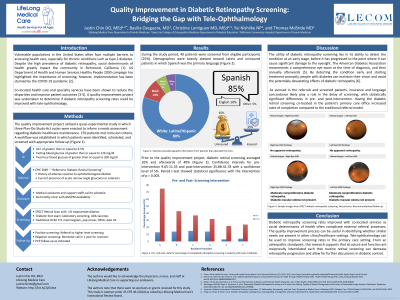Back

Clinical: Outcomes Studies
Quality Improvement in Diabetic Retinopathy Screening: Bridging the Gap with Tele-Ophthalmology
Friday, March 31, 2023
12:00 PM East Coast USA Time


Justin Chin, DO (he/him/his)
Resident Physician
Lifelong Medical Care
Emeryville, California, United States
Presenting Author(s)
Background and Hypothesis: BACKGROUND
Vulnerable populations in the US often face multiple barriers to accessing health care, especially for chronic conditions such as type 2 diabetes. Despite the high prevalence of diabetic retinopathy, social determinants of health greatly impact the community in Richmond, California. US Department of Health and Human Services Healthy People 2030 campaign has highlighted the importance of screening; however, implementation has been stymied by the COVID-19 pandemic.
HYPOTHESIS
Co-located health care and specialty services have been shown to reduce the disparities and improve patient outcomes. A quality improvement project was undertaken to determine if diabetic retinopathy screening rates could be improved with tele-ophthalmology.
Methods: The quality improvement project utilizes a quasi-experimental study in which three Plan-Do-Study-Act cycles were enacted to inform a needs assessment regarding diabetic healthcare maintenance. Patients were recruited from resident panels from a single federally qualified health center with inclusion criteria of age over 18, able to consent to the intervention, and a diagnosis of type 2 diabetes. Patients were excluded if they have already been screened in the past year or were not able to be contacted. 159 patients met criteria in which patients were scheduled for a clinic visit, received topical ophthalmic dilation, and was screened using a portable retinal camera that synced to tele-ophthalmology. Pre- and post- intervention data were obtained in Tableau and EPIC and analyzed using paired t-tests to determine whether having in-house services increased retinal screening rates.
Results: Prior to the quality improvement project, diabetic retinal screening averaged 10% and afterwards of 40%. Confidence intervals for pre-intervention 9.65-11.35 and post-intervention 35.88-41.78 with a confidence level of 5%. Paired t-test showed statistical significance with the intervention of p = 0.003. Demographics were heavily skewed toward Latinx and uninsured patients in which Spanish was the primary language.
Conclusion: Diabetic retinopathy screening rates improved with co-located services as social determinants of health often complicate external referral processes. The quality improvement process can be useful in identifying whether similar needs are present in other clinic/healthcare settings. Tele-ophthalmology can be used to improve screening rates in the primary care setting. From an osteopathic standpoint, this research supports that structure and function are reciprocally interrelated such that routine retinal screening can decrease retinopathy progression and allow for further discussions in diabetic control.
Acknowledgement of Research Study Sponsors and IRB: The authors note that there were no sponsors or grants received for this study. This study is exempt under 45 CFR 46.102(d) as noted by LifeLong Medical Care’s Institutional Review Board.
Vulnerable populations in the US often face multiple barriers to accessing health care, especially for chronic conditions such as type 2 diabetes. Despite the high prevalence of diabetic retinopathy, social determinants of health greatly impact the community in Richmond, California. US Department of Health and Human Services Healthy People 2030 campaign has highlighted the importance of screening; however, implementation has been stymied by the COVID-19 pandemic.
HYPOTHESIS
Co-located health care and specialty services have been shown to reduce the disparities and improve patient outcomes. A quality improvement project was undertaken to determine if diabetic retinopathy screening rates could be improved with tele-ophthalmology.
Methods: The quality improvement project utilizes a quasi-experimental study in which three Plan-Do-Study-Act cycles were enacted to inform a needs assessment regarding diabetic healthcare maintenance. Patients were recruited from resident panels from a single federally qualified health center with inclusion criteria of age over 18, able to consent to the intervention, and a diagnosis of type 2 diabetes. Patients were excluded if they have already been screened in the past year or were not able to be contacted. 159 patients met criteria in which patients were scheduled for a clinic visit, received topical ophthalmic dilation, and was screened using a portable retinal camera that synced to tele-ophthalmology. Pre- and post- intervention data were obtained in Tableau and EPIC and analyzed using paired t-tests to determine whether having in-house services increased retinal screening rates.
Results: Prior to the quality improvement project, diabetic retinal screening averaged 10% and afterwards of 40%. Confidence intervals for pre-intervention 9.65-11.35 and post-intervention 35.88-41.78 with a confidence level of 5%. Paired t-test showed statistical significance with the intervention of p = 0.003. Demographics were heavily skewed toward Latinx and uninsured patients in which Spanish was the primary language.
Conclusion: Diabetic retinopathy screening rates improved with co-located services as social determinants of health often complicate external referral processes. The quality improvement process can be useful in identifying whether similar needs are present in other clinic/healthcare settings. Tele-ophthalmology can be used to improve screening rates in the primary care setting. From an osteopathic standpoint, this research supports that structure and function are reciprocally interrelated such that routine retinal screening can decrease retinopathy progression and allow for further discussions in diabetic control.
Acknowledgement of Research Study Sponsors and IRB: The authors note that there were no sponsors or grants received for this study. This study is exempt under 45 CFR 46.102(d) as noted by LifeLong Medical Care’s Institutional Review Board.
